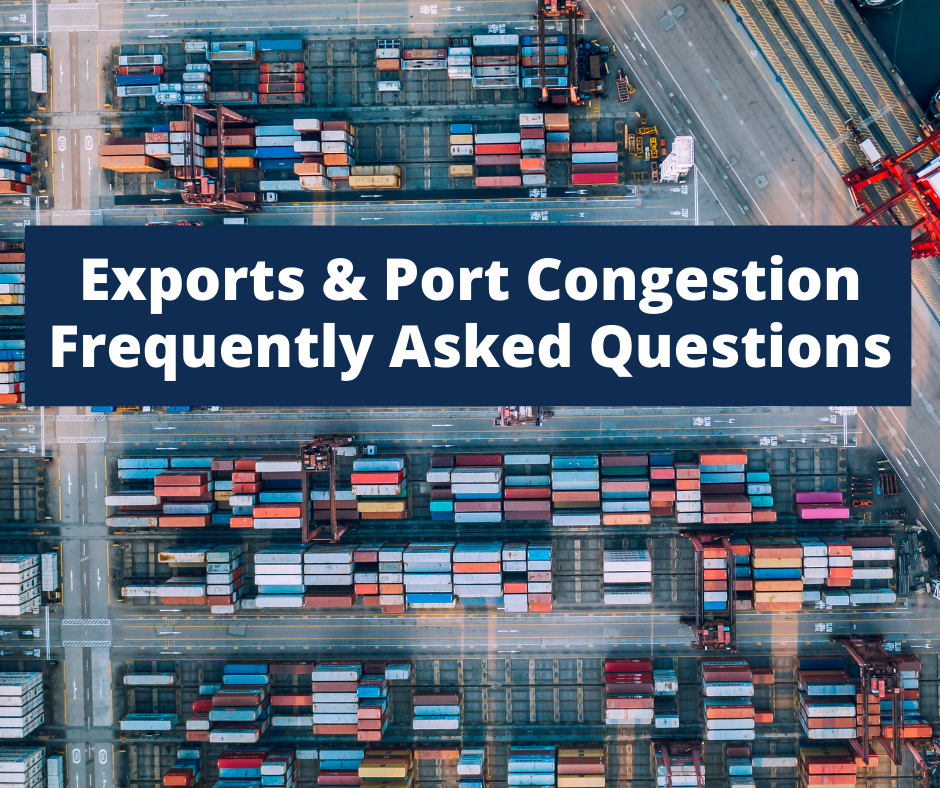Export Congestion FAQ
Questions from exporters…
What is the latest industry congestion news impacting exporters?
- Steamship lines are experiencing unprecedented delays and disruptions due to all manner of problems and issues. Performance is dismal, causing ripple effects through the entire industry, impacting exporters.
- Sailing dates and times are drastically changing each day, resulting in delays. For example, many bookings made in December or January have repeatedly been rebooked and/or have yet to load.
- Several ports are now only accepting exports on designated days as dockworkers focus on clearing import congestion.
- In Chicago, there are about a half dozen international railyards. The continued chassis shortage has left containers stacked awaiting transport, which means less containers for exports.
- Staff representing many steamship lines have turned over given the economics of the last two years. These new industry staffers may or may not understand the processes of intermodal, which can create bottlenecks.
My container is at the port ready to load. Why was it rolled to another vessel?
Vessels currently are overbooked, and steamship line allocation teams are moving overflow to later vessels, as needed. In some cases, bookings are rolled forward several weeks. In some cases, we’re seeing multiple container loads being separated, creating paperwork challenges along with additional delays and disruptions.
I made a booking a month ago. Now I’m being told there is no booking; I may not be able to load for many more weeks; and it may cost more. Why?
Steamship lines are overbooked. Some are cancelling bookings at the last minute, before equipment is released for loading. We then have to request a new booking, with a different carrier, and at an increased cost. The cost may have gone up for one of several reasons, including monthly GRIs as noted above. Sometimes bookings need to be moved to a different carrier, which has a completely different transit route and lead times are drastically changed.
The sail date on my export container changed multiple times, and as a result, I’ve had to change my loading date each time. Is this happening to other clients? What are my options?
Yes, this is happening frequently right now. Because of the current congestion at the ports, steamship lines are changing departure dates constantly. For some vessels, the sailing is changed daily. This causes ripple effects throughout the supply chain, even impacting rail service in the Midwest with booking changes and/or delays. If you have not pulled your container, the best option is to pay close attention to these changes to make adjustments within the supply chain that avoid detention and storage fees.
My container is loaded ready for shipping, and I just found out that the earliest receiving date has been pushed out one week because of the congestion. Now I have to pay the trucker additional fees to store my container. What are my options?
While we know everyone wants more options right now, the best choice in this scenario is to have the trucker hold the container until the rail can accept it for transport to the port. Plan to pay for chassis fees and storage fees to cover the trucker’s additional costs.
Unfortunately, this is becoming a common situation due to congestion. Communicate honestly with your customers that the costs for shipping are going up because of the delays resulting from congestion. Be sure to communicate longer transit times should be expected with extensions to deadlines.
I am being billed additional chassis rental, container per diem charges and redelivery fees. Why?
Due to severe port and rail congestion, the rail lines have begun changing routings and capacity levels. Some are only accepting a limited number of export containers per day, and sometimes not at all. Truckers don’t know if they will be able to in-gate until rail billing is submitted or until they receive a notice from the rail that receiving is closed for that day. When they cannot in-gate, one or more of these fees are charged.
Most rail lines are moving toward a new system requiring advanced appointments for dropping containers. When the appointments have been filled for the day, truckers will have to hold until the next available appointment.
I have shipped hazmat categorized goods for years without issue. Recently, I’ve experienced several problems that have resulted in extra charges. What has changed?
Hazardous cargo requires final approval from the steamship lines hazmat team. When congestion is minimal, this process is normally smooth. But as the congestion increases so do delays.
Final hazmat approval cannot be requested until the container is loaded, and all parties have signed the dangerous goods form. Rail billing cannot be requested until there is final dangerous goods approval from the steamship line. These processes are taking longer than normal due to people who process the paperwork working from home (and in some cases being outsourced professionals).
- If there is no rail billing when the container gets to the rail, the trucker takes the container to their yard for redelivery, resulting in a redelivery fee and additional chassis rental.
- If dangerous goods filings are not approved and/or rail billing is not in before the rail cut off, the booking can be rolled, and rail billing has to be applied to the new vessel with a delayed rail earliest receiving date and cut off resulting in additional chassis rental fees and possibly per diem charges (container rental charged by the steamship line if the container is out longer than their standard allowed time).

